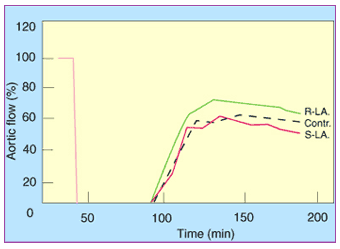 In fact, in later tests, the scientists found that while R(+)-Lipoic Acid was able to improve blood flow into the aorta at extremely low concentrations, it took a dose of the S(-)-enantiomer which was as much as twenty times as great to provide any significant advantage over no treatment at all - and even then, the benefit of the S(-)-form was still less than was seen at the twentyfold lower concentration of R(+)-lipoic acid!69
In fact, in later tests, the scientists found that while R(+)-Lipoic Acid was able to improve blood flow into the aorta at extremely low concentrations, it took a dose of the S(-)-enantiomer which was as much as twenty times as great to provide any significant advantage over no treatment at all - and even then, the benefit of the S(-)-form was still less than was seen at the twentyfold lower concentration of R(+)-lipoic acid!69
Deep down in the mitochondria, the contrast was even more profound. When the scientists isolated the mitochondria from the animals' hearts after the "heart attack," having infused the hearts of different animals with different concentrations of either R(+)- or S(-)-lipoic acid, they found that mitochondrial energy production was boosted at even tiny concentrations of R(+)-lipoic acid, and continued to climb as the dose was increased. By contrast, no amount of the S(-)-form was found sufficient to increase the production of ATP.
But if the S(-)-enantiomer was unable to jumpstart mitochondrial energy production at any concentration, then how did it manage the weak increase in blood flow seen in the animals infused with extremely high levels of the compound? To answer this question, you have to understand that under certain conditions, the complex V turbine can actually be made to run in reverse, tearing down ATP to make the low-energy carrier molecule, ADP. When this happens, the mitochondria actually consume ATP more than they make, so that the cell loses the very energy the mitochondria are supposed to be producing.
So how did the two forms of lipoic acid affect this potentially disastrous tendency? By now, you've probably got a pretty good guess. At realistic concentrations, R(+)-Lipoic Acid slowed down the tendency of mitochondria to cannibalize their own ATP; by contrast, the S(-)-enantiomer accelerated it. 69 The same effect had previously been seen in the isolated, "inside-out" mitochondria. 11 But at the extremely high concentrations of the S(-)-form at which a small benefit to blood flow was seen, the pattern reversed itself, so that at these ultrahigh levels the R(+)-enantiomer no longer inhibited the teardown of ATP, while the S(-)-form began to do so.
If you're thinking that this means that the S(-)-enantiomer might actually benefit you, if you could only take enough of it - or that you'll lose one of the advantages of R(+)-Lipoic Acid if you take too much of it - think again. The concentrations that were needed to achieve this curious inversion were dozens of times greater than those achieved in humans after injecting them with 1200 mg of racemate lipoic acid. 24 In a nutshell, this is a property of the S(-)-enantiomer you're never going to get from a supplement in the real world.
Learn More About Youthful Spring
Please consult with a health care professional before starting any supplementation program. The information contained on this site is general in nature and Company does not take any responsibility for any errors that may appear. Company has made every attempt to make the information as accurate as possible. However, Company does not warrant its accuracy. Please note that the statements on this web site have not been evaluated by the FDA.








 In fact, in later tests, the scientists found that while R(+)-Lipoic Acid was able to improve blood flow into the aorta at extremely low concentrations, it took a dose of the S(-)-enantiomer which was as much as twenty times as great to provide any significant advantage over no treatment at all - and even then, the benefit of the S(-)-form was still less than was seen at the twentyfold lower concentration of R(+)-lipoic acid!69
In fact, in later tests, the scientists found that while R(+)-Lipoic Acid was able to improve blood flow into the aorta at extremely low concentrations, it took a dose of the S(-)-enantiomer which was as much as twenty times as great to provide any significant advantage over no treatment at all - and even then, the benefit of the S(-)-form was still less than was seen at the twentyfold lower concentration of R(+)-lipoic acid!69